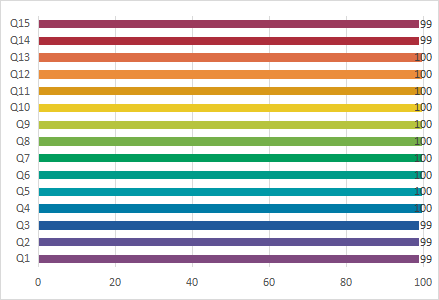
What's CRI, IES TM-30, TLCI & CQS and Why is It Important? Part.2
In our last article, we discussed TM30. In this article, we will learn about two more concepts TLCI and CQS.
1.TLCI
LED light sources have become increasingly popular in film and television shooting due to their energy efficiency and durability. High CRI index light sources are sometimes used in these environments due to the unique principles and spectral distribution of LED light sources. The output image may also have colour deviations due to a mismatch between the spectral components and the colour characteristics of the camera's photosensitive chip. These deviations can be corrected to some extent through later adjustments, but this process is time-consuming and costly, and the results are often unsatisfactory.
This requires a new measurement standard that accurately reflects the perception of light colour by the human eye, as well as the camera's reception of light colour and the degree of colour restoration. The Television Lighting Consistency Index (TLCI) was proposed by former BBC engineer and optical expert Mr Alan Roberts in collaboration with the European Broadcasting Union (EBU) in November 2011. The spectral energy distribution of the measured light source is tested using a spectral radiation tester. The test results of TLCI are then calculated and obtained using analysis software.
To summarize, the TLCI index (Television Lighting Consistency Index) is an alternative method developed to address the drawbacks of CRI. TLCI attempts to provide more accurate color fidelity predictions for the light sources used in broadcasting, taking into account the slight difference between the way cameras interpret light and the way humans perceive it. The high TLCI indicator indicates that light sources will render colours well in movie or photography .
Television studios typically require a minimum TLCI score of 90 to ensure high-quality lighting for programs. This score provides a quick and accurate way for photographers and lighting engineers to measure lighting quality, reducing the need for extensive testing and post-processing.
With advanced LED technology, Yujileds® focuses on providing specific solutions for photographers and TV lighting manufacturers with high TLCI LEDs.
For instance, Yujileds® full spectrum series of violet chip powered LEDs (VTC) has a TLCI value of up to 99. This LED is an excellent choice for high-quality lighting.

2.CQS
CQS is an indicator used to evaluate the colour quality of light sources. It was proposed by the Luminance Society of America (IES) in 2015 to compensate for the shortcomings of the Color Rendering Index (CRI). Unlike CRI, which only considers the reproducibility of light sources for a small number of specific colours, CQS takes into account other important factors.

The CQS (color quality index) evaluates a light source's ability to restore an object's color by considering factors such as color reproducibility, saturation, and brightness. This provides a more accurate reflection of the human eye's perception of light source color.
The model links the emission spectrum of light sources with the results of human eye perception of various colours. CQS utilises a statistical model that is based on experimental data of human eye perception to calculate the relative evaluation of a light source's true perception of colour. The evaluation score ranges from 0 to 100.
To calculate the CQS score, you need to obtain spectral data of the light source to be evaluated. Then, compare the spectral data with a set of standard reference spectra to obtain the corresponding color difference value. Finally, convert the color difference value to a CQS score.
It is equally important for lamp manufacturers and consumers to understand and use CQS correctly.
Light sources with high CQS have better color reproduction, resulting in colors that are closer to the original object and better visual effects. Lamp manufacturers can enhance their market competitiveness by improving their Colour Quality Scale (CQS) and ensuring their products meet customer requirements for lighting fixture colour rendering quality. At Yujileds®, we provide customers with high CQS products and testing data to deliver superior quality lighting.

The CQS index can assist customers in selecting appropriate light sources for various scenarios. Art professionals require light sources that accurately showcase the original colors of artworks, making it necessary to choose sources with high CQS scores. For home or office use, comfort is a priority, while specific needs may require light sources with varying CQS scores.

Leave a comment